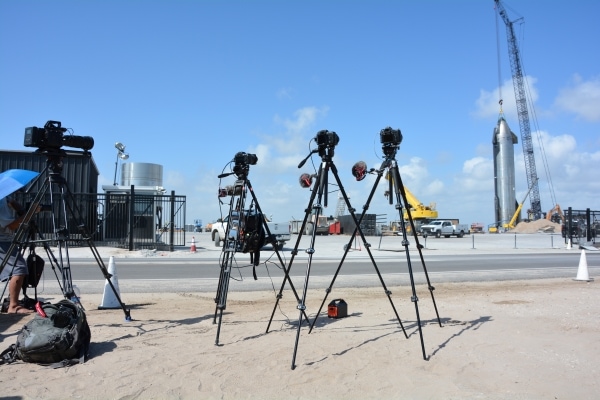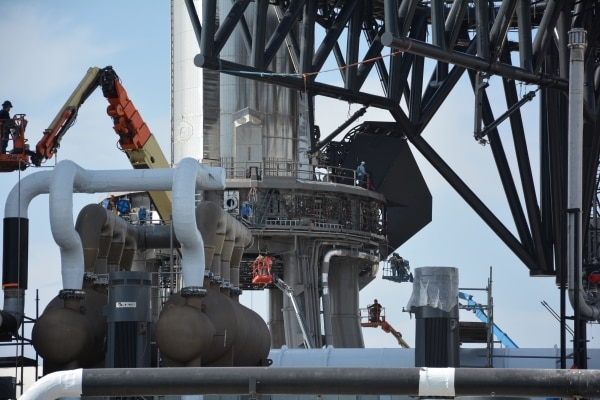On April 20th, 2023, SpaceX attempted the first integrated flight of its biggest rocket called Starship. SpaceX is a private American aerospace company that was founded in 2002 by the South African-born business magnate – Elon Musk. From the launch pad in Boca Chica in south Texas, Starship flew for four minutes and reached an altitude of 39 kilometres, but its flight was terminated after the spacecraft started to tumble and lost several of its engines. A few days after the long-awaited event, Elon Musk appeared for an interview at a popular TV show with the comedian Bill Maher. Among many of his titles, Musk was introduced as Tesla’s Technoking (which is the official title that Musk holds at the company). The often-sharp-tongued host showered the billionaire with pleasantries but rather than his unusually smarmy attitude, it was what Maher presented as the “alternative” view of history that struck me the most. “When you study history…” – Maher mused – “there is the great man theory and they talk about kings and princes and queens and presidents, [but] it’s really the people in tech who change the world. They’re the people who deal the cards, whether it’s fire or electricity – for good or bad – or the cotton gin or the iPhone or the atom bomb, those are the cards and the rest of us just play it.”
Maher is not alone is his assessment; in most popular understandings, technology is usually thought of as a product of quirky tech visionaries and as such, external to society. According to this way of thinking, people have to adapt to new technological inventions and are subjects to their “impacts”. An anthropological perspective on technology, on the other hand, treats it as just another material object and a set of social behaviours that are produced by humans and hence, are deeply steeped in beliefs, values and myths (Pfaffenberger, 1992). Although anthropologists are often excellent at deconstructing the social makings of any technology, we may sometimes forget to apply the same approach when it comes to our critiques of the relation between technology and the dominant economic discourses. Capitalist relations constitute powerful societal forces spanning the entire globe, there is no doubt about that. However, can thinking about non-terrestrial worlds push back against these dominant analytics and thus, help us reimagine social and technological relations not only in space, but also here on Earth?
Technologies, and economic relations that they are bound up with, rest on certain ethical grounds, rather than being merely an automatic outcome of capitalism. Multiple possibilities are always present in any society (Graeber, 2014) so the “fate” of a new technology is not necessarily predetermined by its perceived affiliation with a particular economic narrative. Despite these ideas, it may often seem like the dynamics of capital overpower any social counterforces. Yet, we miss a whole set of complex social and cultural processes by adopting that perspective. In this essay, I aim to bring some of them into view to speculate about how the social and the technological could be rethought in non-terrestrial environments such as Mars.
“They must get it” – I think to myself as I look around the room where a group of SpaceX enthusiasts have gathered to watch a YouTube stream with a weekly round-up of developments at the company’s production and launch facilities in Boca Chica. During the three-hour stream the commentators go through hundreds of close-up and panoramic photos of Starbase (as the SpaceX’s facilities in Boca Chica are called). The aim is to meticulously record all changes, decipher the purpose of newly arrived parts and equipment and speculate about the design and operation of the ground systems as well as the Starship/SuperHeavy combo.
Starship/SuperHeavy is the biggest rocket ever built, standing at 120 metres tall and able to lift more mass than Saturn V which blasted astronauts to the Moon over half a century ago. People in the room can appreciate the level of detail with which the commentators on the stream talk about the special type of concrete used under the orbital launch mount, various types of pumps that are pushing propellants into the rocket, down to the number of bolts or conduit paths. All of these details are fascinating for those who have been following the development of this spacecraft and witnessed how its design and operation have been subject to many iterations and more or less spectacular failures. Even though it is impossible to predict the company’s next move or know for certain what prompts particular changes, to the people in the room, Starship is far from a technological “black box”. It is largely stripped of its mystique through SpaceX enthusiasts’ deep familiarity with its development; they gain this familiarity by observing the movement of people and equipment around the production and launch sites on a daily basis. The room that I am in (and the area surrounding it) may then be the best place to explore the social making of Starship and the possibilities for reimagining the relation between the social and the technological – on Earth and in outer space.
I have spent around eight months conducting ethnographic fieldwork next to Starbase at the very southern tip of Texas. Seeing the excitement of space enthusiasts and SpaceX fans from near and far, I often wondered whether it could be a sign of more fundamental social potentialities that were transforming our common reality.
Labour of imagination
To many people in this room, Elon Musk appears as contemporary Prometheus – a hero and a rebel who challenges the stale rules of the game in any industry that he becomes involved in. He also garners support for his ideas from people across the social and political spectrum, as if following in the footsteps of his archetype who by stealing fire, connected the realm of mythical gods with the earthly mundanities of humanity. The difference is, though, that the futures that Musk is projecting are not supposed to be mundane even in the slightest degree. SpaceX’s appeal is built on the premise that the spacecraft that the company is building will one day make humanity a multi-planetary species, no less. When asked why he embarked on such an ambitious mission, Musk (who is SpaceX’s CEO and also retains the title of the company’s Chief Engineer) often repeats that he wanted to make people feel excited about the future. It would be easy to dismiss such pronouncements as speculation speak – a form of hyperbolic language and a material projection that is aimed at accumulating capital in anticipation of the “real” capital-generating activity. But seeing the faces of space enthusiasts light up when they talk about SpaceX, makes me want to treat such pronouncements seriously to explore if they are perhaps more than a trickster tactic aimed at making people believe in a pipe dream, as some critics of SpaceX would say.
Through their engagement with the cosmos, space enthusiasts perform, what I would call, building on Laura Bear’s work on speculation (Bear, 2020), the labour of imagination. Some of them “merely” follow the developments at Starbase in person or online. Others use photography, video and other forms of online content creation as technologies of imagination that make Starbase accessible to a global audience, thus also validating and possibilising space travel. Space enthusiasts who work as YouTubers, photographers and film makers are instrumental in helping others experience space exploration in a more direct way: “I really try to capture with my art specifically what it feels like to be at Starbase… hopefully, grounded in reality pretty well… because it is really a profound experience… Being there is a different experience from just seeing it… The majesty of these pieces of engineering that are, hopefully, going to get us to other destinations in our Solar system, there’s the grandeur of engineering and there’s the grandeur of the vision behind it that is very inspiring.” When asked about what they were doing their work for, one Starbase photographer told me: “people, if [Starship is] successful, will look back and wonder what were the first steps of humanity getting to the Moon again or Mars for the first time and I feel like I’m involved in that process somewhat extemporaneously… I look back at many of the old Apollo pictures and I’m glad that there’s a photographer who captured what it felt like to be there, not exactly what it looked like or exactly how it happened but just the feeling of the grandeur of being there. And I’m really hoping to be able to provide that to the future. I want to preserve the photons in a way that other people can enjoy.”
“[SpaceX are] actually concerned about getting the thing done” – another space enthusiast told me – “instead of ‘oh, let’s take this money that we’ve got from the government and stretch it out as far as we can’, which is another model for old space versus new space… it’s just extremely refreshing.” By talking and hanging out with space enthusiasts, it became clear to me that Starship revitalises the feelings of achievement, potential, grandeur and technological advancement. It also carries on the trope of American imagination i.e., the belief in manifest destiny and the imperative to spread the ideology of American Dream to the stars (McCurdy, 2011). However, it also has a much more contemporary meaning; the rocket offers a material and discursive representation of a transmutation of capital (Kapferer and Kapferer, 2021) i.e., a moment when old economic orders and productive forces are devalued and make room for the creation of new relations and markets. At this point in history, Starship acts as a counterforce to the dynamics of socio-economic impotence exploited by such actors as Donald Trump and the politically correct stalemate enacted by socially liberal yet resolutely capitalist parties. Capitalism has generated limitations within itself that it must now overcome by reconstructing and rebranding its emphasis. The rocket is by no means the only vehicle for countering these forces, but it offers a useful case study in how social and technological dynamics play into the transformation of capital. Starship helps capital renew its potency not only by revitalising the discourses of American-led technological progress, but also by offering a potential for expanding its scope into outer space. SpaceX gives credence to space travel and extraterrestrial resource exploration. Space enthusiasts for their part are thrown into the middle of these tumultuous and sometimes contradictory processes.
The labour of imagination and its technologies that space enthusiasts employ show that the social imaginaries that they help create through their work attempt to “bring space down to Earth for everyday people” (as the motto of one space creator puts it). Thus, these imaginaries are often liberatory or egalitarian in nature to begin with, but over time, they may come up against powerful economic and political forces. In this respect, Starship is no different from any other technology. Will it, then, be a technology of freedom or control?
Starship and the future
Among many space enthusiasts that I spoke with, Starship evokes visions of an entirely different society, organised around the principles of efficiency and common responsibility. If these are compatible with freedom or hyper-control is a little bit less clear. However, while ideas for a new social contract on Mars necessarily remain a bit murky at the moment, the rocket (and the imaginaries of space exploration accompanying it) are already reimagining capital. They firmly expand its scope and resource base into outer space, discursively doing away with the earthly “limits to growth”. They advocate space travel as a common goal of all humanity on the basis that it is to become widely available instead of catering to the caprices of the few wealthiest individuals. Space exploration is also supposed to be efficient thanks to the reusability of the new generation of spacecraft such as SpaceX’s Starship. None of these goals are necessarily novel, but what’s new is the way in which they succeed in advancing the case for a corporate-technocratic governance models that are portrayed as more efficient, cost-effective and forward-looking than older forms of government such as the nation state.
From this perspective, Starship appears as a product of rational economic conduct because it could offer a solution to many Earthly ills such as: the climate crisis, potentially deadly asteroid strikes or a shortage of resources. However, by reimagining capital as an interplanetary saviour of humanity, the rocket also helps to re-engineer the social in the process. On Earth, this is already going on in the form of an emerging digitalised society that becomes the domain of hyper-control by the most powerful corporations; however, Starship also makes it possible that the entire process will be influenced by the (real or imagined) governance structures and procedures necessitated by the radically different conditions found in extraterrestrial realms. Even if Starship does not become the rapidly reusable vehicle that allows ordinary people to travel through cosmos, the discourse of transformation can still prompt changes in terrestrial and extraterrestrial governance. What I’ve learnt by hanging out with space enthusiasts and sceptics alike, is that far from being an agent of expanding capitalism, as it is often portrayed by its opponents, Starship actually manifests the contradictions of these processes.
Technology has an extraordinary capacity to represent opposite things to different people. In the general media and political discourse, Starship appears rooted in American culture, especially in western and frontier myths. A fair dose of messianism and millenarian hope can also prevail among the most ardent of Musk’s fans. To others, the rocket represents a persisting symbol of national imperialism and colonial expropriation. The liberatory potential of space exploration, however, doesn’t lie in the elite and military visions of a multi-planetary species or settlement and dominance in space. Wanting as they are, they have one positive effect – they invite (indeed, dictate) speculation about more just and free alternatives.
If we were to take any cues from the social lives of space enthusiasts in south Texas, we could speculate about the tight entanglement of the social and the technological in extraterrestrial contexts. Human life in space would probably be highly dependent on technology for even the most basic of its functions and Space enthusiasts may well be the early progenitors of Starship knowledge. Their active engagement with the development process and intimate knowledge of the spacecraft and its ground systems may be similar to the degree to which future societies in space would have to become familiar with their extraterrestrial technologies. Even their (relative) isolation and the harsh natural environment in which space enthusiasts work in Texas may be seen as an analogue of the kind of self-dependent living that future communities would have to cultivate in space. This may undermine the currently predominant view of technology as a product of tech visionaries. Technology may become “de-alienated”. Its everyday operation and maintenance would be so central to sustaining life – and perhaps constitute a key part of every person’s day – that people would no longer perceive it as something external to their societies. Technology may also become part of what we consider human as it becomes incorporated into our biological bodies in ever new ways. How could that influence governance in space? Would capitalism still work well with this reimagined, social view of technology? There are multiple possibilities here and far too many for this short essay. Suffice to say, there are no obvious patterns that have to emerge and nothing has been determined yet.
Starship’s place is paradoxical because it is both a driver and an effect of future-making forces. It invites speculation about the future of humanity as much as it enacts it in its material construction and economic narrative. Future visions that it propagates appear, then, simultaneously open and closed.
In moments of self-reflection, some space enthusiasts that I spoke with, sometimes wondered how history was going to judge their devotion to Elon Musk and their hope in SpaceX – were they too passionate to see the “obvious” limitations of his project? Or would they be championed as early visionaries? Whatever the final outcome, looking at Starship from the vantage point of those who follow its development very closely can remind us that technology is social and hence, always an avenue that allows us to see social, political and economic alternatives. Insisting on the technology’s liberatory potential may sometimes mean using its intended meanings for unintended purposes. It is inevitable that at some point, sweeping economic and political forces will try to co-opt emerging technologies for their own purposes. However, these forces are neither all-powerful nor uniform so there may still be room for change. As anthropologists, our task may be to carve out a space for this kind of work. We could identify the cracks in smooth narratives and dominant social processes and populate them with critical and analytical speculation, even though the latter will necessarily be quite risky at a time when nothing is certain.
References
Bear L (2020) Speculation: a political economy of technologies of imagination. Economy and Society 49(1): 1–15. DOI: 10.1080/03085147.2020.1715604.
Graeber D (2014) On the moral grounds of economic relations: A Maussian approach. Journal of Classical Sociology 14(1): 65–77. DOI: 10.1177/1468795X13494719.
Kapferer B and Kapferer R (2021) The Trump Mediation. Arena Quarterly, March. Available at: https://arena.org.au/the-trump-mediation (accessed 2 May 2023).
McCurdy HE (2011) Space and the American Imagination. second edition. Baltimore: Johns Hopkins University Press.
Pfaffenberger B (1992) Social Anthropology of Technology. Annual Review of Anthropology 21. Annual Reviews: 491–516.
Featured image provided by author












